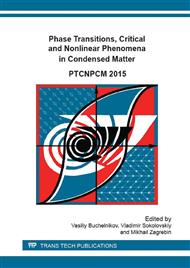[1]
C. Duan, J. Tong, M. Shang, S. Nikodemski, M. Sanders, S. Ricote, A. Almansoori, and R. O'Hayre, Readily processed protonic ceramic fuel cells with high performance at low temperatures, Science 349 (2015), 1321-1326.
DOI: 10.1126/science.aab3987
Google Scholar
[2]
U. Сhowdhry, J.R. Barkley, A.D. English, A.W. Sleight, New inorganic proton conductors, Mat. Res. Bull. 17 (1982) 917-933.
DOI: 10.1016/0025-5408(82)90013-7
Google Scholar
[3]
B.G. Polevoi, V.A. Burmstrov, E.I. Burmakin, Proton conduction in hydrous antimony pentoxide, Inorg. Mater. 27 (1991) 2218-2220.
Google Scholar
[4]
D.A. Zakharyevich, Yu.N. Kuryleva, Isolation of radioactive wastes components in Antimonates, Radiation Safety. 1 (2015) 15-23 (Rus).
Google Scholar
[5]
C. Michel, O. Groult, B. Raveau, Sur de noveaux pyrochlores ASbWO6 [A = K, Rb, Cs, Ti], Mat. Res. Bull. 8 (1973) 201-210.
DOI: 10.1016/0025-5408(73)90173-6
Google Scholar
[6]
V.A. Burmistrov, D.A. Zakhar'evich, Ion-conducting defect pyrochlore phases in the K2O-Sb2O3-WO3 system, Inorg. Mater. 39 (2003) 68-71.
Google Scholar
[7]
A.V. Knyazeva, I.G. Tananaev, N. Yu. Kuznetsova, N.N. Smirnova, I.A. Letyanina, I.V. Ladenkova, Crystal structure and thermodynamic properties of potassium antimony tungsten oxide Thermochimica Acta 499 (2010) 155–159.
DOI: 10.1016/j.tca.2009.12.002
Google Scholar
[8]
M. Riviere, J.L. Fourquet, J. Grins, M. Nygren, The cubic Pyrochlores H2xSb2xW2-2xO6 n(H2O); structural, thermal and electrical properties, Mat. Res. Bull. 23 (1988) 965-975.
DOI: 10.1016/0025-5408(88)90051-7
Google Scholar
[9]
V. A. Burmistrov, D. A. Zakhar'evich, D.G. Kleshhev, Proton conductivity of ammonium antimonate NH4HSb2O6·nH2O (0 ≤ n ≤ 1) Russ. J. Inorg. Chem. 47 (2002) 1864-1866.
Google Scholar
[10]
K.D. Kreuer, Proton Conductivity: Materials and Applications, Chem. Mater. 8 (1996) 610–641.
Google Scholar
[11]
B.G. Polevoi, N.N. Nastenko, E.I. Burmakin, Protonic conduction of silicoantimonic acid, Sov. Elecrochem. 28 (1992) 1261-1265.
Google Scholar
[12]
K. Ozawa, Y. Sakka, M. Amano, Preparation and electrical conductivity measurement of amorphous antimonic acid, J. Ceram. Soc. Jap. 104 (1996) 756-759.
DOI: 10.2109/jcersj.104.756
Google Scholar
[13]
D.A. Zakharyevich, A.V. Neustroev, Proton conduction through interface phase of CPAA/KDP composites, Mater. Res. Soc. Symp. Proc. 1256E (2010) 1256-N16-42.
DOI: 10.1557/proc-1256-n16-42
Google Scholar


